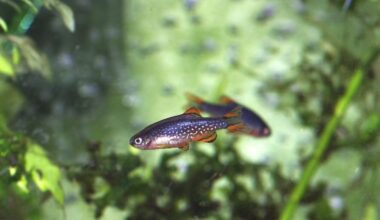Did you know that some of the most aggressive freshwater fish for aquariums are also the most popular?
This is something that many new aquarists don’t realize at first, because they view aggressiveness as a bad thing. We thought the same thing when we got started too.
And there’s a simple reason for this:
Many aggressive fish are actually really neat! You can discover species with a wide variety of interesting behaviors and appearances if you’re not afraid of a little feistiness.
And the more you learn, the more you realize that aggressiveness isn’t a scary trait that should discourage you from owning a particular species of fish. In fact, once you know how to manage this aggression everything gets pretty simple!
This list of aggressive freshwater fish will help you see what options are out there, and settle on a species that interests you.
1. Tiger Barb
Tiger barbs have a reputation for being mildly aggressive fish. They have a penchant for nipping at flowing fins and bullying more passive species. As a result, proper planning is essential if you want to keep them in a community environment.

The good news is that you can easily keep a group of Tiger Barbs together. They’re a shoaling fish and prefer to stay in groups of at least six. Oftentimes, having that social interaction will help to stave off aggressive behavior.
Keeping a family of Tiger Barbs together can produce a stunning show in your tank. These fish are covered in a yellowish-orange base color. Complementing the base color are four vertical stripes. They create a tiger-like appearance, which inspired their namesake.
Overall, Tiger Barbs are relatively hardy. They tolerate a wide range of conditions. Though, they do best in soft water with some light acidity.
- Size: 3 inches
- Difficulty: Beginner-Intermediate
- Minimum Tank Size: 30 gallons
2. Red Tail Shark
The Red Tail Shark is a fun fish species to own. Highly active and naturally curious, these fish spend most of their time darting back and forth at the bottom of the tank. They like to investigate every nook and cranny of the aquarium.
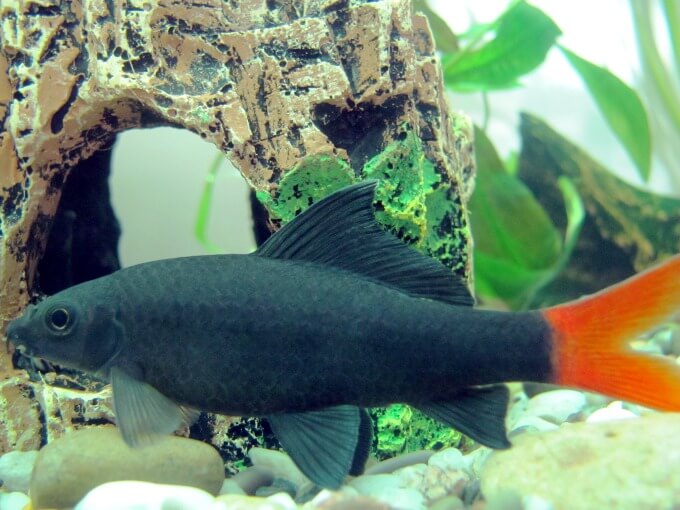
They need ample space and a well-decorated aquarium to truly thrive. Otherwise, their aggressive tendencies will become more apparent.
Visually, these fish are quite simple. However, it’s that simplicity that makes them beautiful! The entire body is covered with dark black. The only exception is the tailfin, which is a vibrant red.
Red Tail Sharks come from freshwater lakes and streams in Thailand. In the wild, fish are considered to be critically endangered. Luckily, you can still find them in the aquarium trade.
They are very hardy and adapt well to life in captivity. With the right care, these fish can provide you with many years of enjoyment.
- Size: 6 inches
- Difficulty: Intermediate
- Minimum Tank Size: 55 gallons
3. Flowerhorn Cichlid
This gorgeous cichlid species originally came from Southeast Asia. However, since its discovery, it has spread throughout the globe. In areas outside of Asia, wild populations were caused by pets being released into the wild.
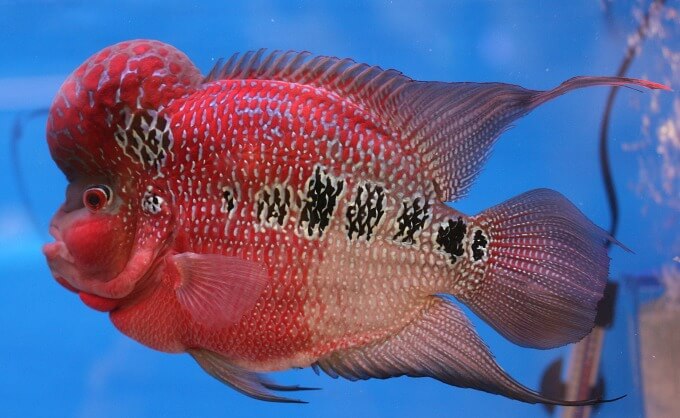
Flowerhorn Cichlids are easy to identify with their coloration and shape. The most prominent feature of the fish is the nuchal hump, which is very large on male specimens. Prominent lips, a lumpy chin, and bulging eyes round off the physical features.
As for color, the fish is predominantly pink. Bright Fuschia pink covers the front part of the body before fading to a more muted shade near the tail. Several large black spots run laterally on the body to give the fish some unique detail.
Like many other Cichlid species, Flowerhorns are quite aggressive fish. But, they’re also very playful. They’re known to respond to human interaction and put on a show!
- Size: 12 to 16 inches
- Difficulty: Intermediate
- Minimum Tank Size: 70 gallons
4. Bucktooth Tetra
Best in a single-species tank, the Bucktooth Tetra is an attractive fish that will add a lot of shimmer to your aquarium. The fish is covered in silvery gray. Part of the body is semi-transparent, which only makes the shiny portion pop out even more.
Two large black dots are the species’ signature markings. One dot is on the center of the body while the other is on the base of the tail. You will also notice hints of yellow on the top of the body and subtle splashes of red on the fins.
Bucktooth Tetras have some unique behavioral quirks. When kept with other species (even other tetras), they’re notorious for ripping off fish scales and eating them! Needless to say, keeping them with other types of fish is not recommended.
It’s best to keep them in groups of at least 12. Smaller groups may result in battles for dominance, so the more fish the better!
- Size: 5 inches
- Difficulty: Intermediate
- Minimum Tank Size: 55 gallons
5. Afer Knife
The Afer Knife fish is widely distributed all over western and central Africa. They live in densely planted rivers. In most cases, they stick to the riverbed and search for prey.
In captivity, they prefer similar living conditions. Afer Knife fish do best when they live in dimly lit aquariums that are decorated with plants and driftwood. Keep the water movement to a minimum and give the fish several places to hide.
Afer Knife fish are very predatory. They don’t do well with others. Even those of the same species should be avoided to prevent territorial disputes.
Feeding these fish can be fun to watch. Because they’re predatory, they prefer having access to live foods. You can provide lance fish or other live feeder fish species. Shrimp, earthworms, and bloodworms work well, too.
If live foods are unavailable, Afer Knife fish will also accept carnivorous pellets or frozen snacks that are rich in protein.
- Size: 20 to 30 inches
- Difficulty: Intermediate-Expert
- Minimum Tank Size: 150 to 200 gallons minimum
6. Jaguar Cichlid
It’s not hard to see why the Jaguar Cichlid has its name. The fish is covered in black splotches, giving it the appearance of a Jaguar.

Interestingly enough, the Jaguar Cichlid doesn’t start off that way. As juveniles, they are silver with a hint of pale gold. Thick stripes of black wrap around the top of the body. Once the Cichlid gets older, their appearance changes to take on those iconic spots.
Jaguar Cichlids are fierce predators. They’re built for fast swimming and have jaws that extend out very far. Pair that with spiny fins and you have a fish that’s more than ready to protect itself.
With that predatory nature comes a hunger for live food. When they’re young, the fish can do just fine on pellets and flakes. But adults will need protein-packed foods. They do well with feeder fish, crickets, earthworms, and more.
- Size: 14 to 16 inches
- Difficulty: Intermediate
- Minimum Tank Size: 70 gallons
7. Dwarf Pea Puffer
Don’t let the cute and unassuming looks of the Dwarf Pea Puffer fool you. They’re quite aggressive and have no problem fighting with other fish.

As a result, they do best with other fish of the same species. Just make sure that there’s enough room for every fish to have some time alone. Otherwise, you might run into some territorial disputes.
A well-decorated tank is a must-have for these fish. They come from rivers and lakes in Southwest India. There, the waters are teeming with life. To keep your fish healthy, it’s best to replicate those conditions as closely as possible.
Fill the tank with tons of vegetation. The plants will act as a hiding spot for the fish whenever they’re feeling a bit threatened. The same goes for rock formation and driftwood.
Dwarf Pea Puffers are curious creatures, so don’t be surprised if you see them investigating every inch of your tank.
- Size: 1.5 inches
- Difficulty: Intermediate
- Minimum Tank Size: 10 gallons
8. Wolf Cichlid
Wolf Cichlids are beefy fish with an intimidating look. Their bodies are quite muscular, which helps when they’re chasing prey. A large mouth, robust jaws, and some sharp teeth help them consume prey as well.
The base color of the ranges from rich yellow gold to a more muted silver. On top of that, you’ll find specks of blue, black, and purple.
One interesting thing about the Wolf Cichlid is its perceived intelligence. These fish are known to be highly astute to whatever is going on outside of the tank. You might see them watching you through the glass. Many will also follow you or respond to your presence!
Wolf Cichlids are quite active even when you’re not watching them. They require a lot of open swimming space and soft sandy substrate for burrowing. To provide some shelter, rocks and decorative shelters are good, too.
- Size: 28 inches
- Difficulty: Intermediate
- Minimum Tank Size: 120 gallons
9. Black Wolf Fish
Naturally found throughout the Amazon River Basin, the Black Wolf Fish is a natural-born predatory. It prefers to stick to the bottom of the water column where it can keep a watchful eye on any prey that’s unlucky enough to swim by.
The appearance of the fish helps it blend in nicely in natural environments. It’s covered in brown and features a thick lateral stripe of black.
In captivity, the Black Wolf Fish makes an excellent showpiece. It’s best kept alone. Though, it can live other fast-moving aggressive fish of a similar size.
Black Wolf Fish prefer warmer waters between 76 and 82 degrees Fahrenheit. Relatively neutral pH levels are preferred, too. Though, the fish can tolerate some fluctuations without any issues.
As for food, live prey is always best. They enjoy snacking on live fish and insects. They can be weaned onto frozen foods. However, those foods need to be packed with protein to keep the fish healthy.
- Size: 20 inches
- Difficulty: Intermediate
- Minimum Tank Size: 120 gallons
10. Convict Cichlid
Convict Cichlids are one of the most popular species in the Cichlid family. They’re a beautiful species that loves to stay active. Typically, you can find these fish swimming in open water in the middle of the water column.
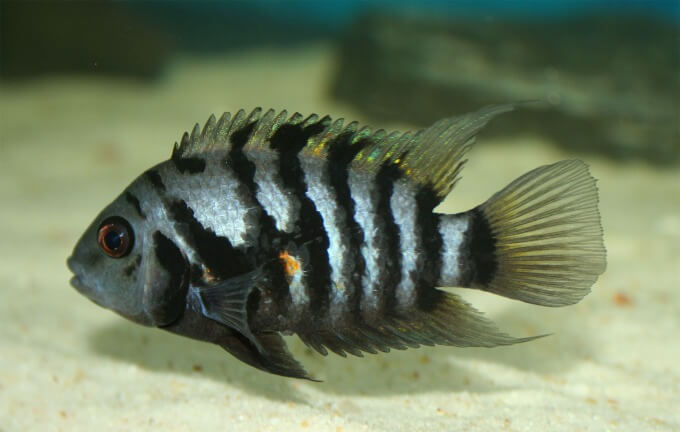
The background color of the fish is silvery gray. Complementing that base color are several vertical stripes of black. They create a look that’s similar to prisoner uniforms, which is why they have the name of Convict Cichlid.
In the right lighting, you might also notice some random pops of color. The fins take on an iridescent sheen, creating a sparkling spectrum of colors.
While they might be aggressive fish, Convict Cichlids are easy to manage with careful planning. They do best in large tanks with plenty of hiding places. Rocks, driftwoods, and artificial caves are essential for helping the fish feel safe.
When you have all of those things, aggressive behaviors are less likely.
- Size: 4 to 5 inches
- Difficulty: Intermediate
- Minimum Tank Size: 30 gallons
11. Jewel Cichlid
Next up is the Jewel Cichlid. This fish comes in a variety of different color morphs. The most popular is the classic red.

These fish take on a bright reddish-orange color. Bluish-green spots cover the entire body. This includes the fins! The spots glow in low-light conditions, giving the fish its jewel-like appearance.
Like most other Cichlids, Jewels are known for being aggressive. However, you can easily manage their aggression levels by simply providing the right environment.
They need a lot of space to avoid getting territorial. You should also fill the aquarium with plants, rocks, and hides. The goal is to give your fish opportunities to have their own space. When the tank is cramped or barren, Jewel Cichlids have nothing to focus on but tankmates, which could lead to fighting.
- Size: 6 inches
- Difficulty: Intermediate
- Minimum Tank Size: 30 gallons
12. Severums
Also known as Banded Cichlids, Severums are endemic to South America. They’re usually found in the northern part of the Amazon region, living in streams and lakes.

Severums are, without a doubt, one of the more interesting-looking fish in the Cichlid family. A strong forehead and shallow chin create a more rounded profile. Males also have distinct worm-like markings on the head.
For the most part, Severums are peaceful compared to other Cichlid species. They do fine in community tanks and will often not cause any trouble.
However, that all changes when it comes time to spawn. Severums are fiercely protective of their eggs and baby fry. They will resort to aggression to keep their young safe.
For this reason, it’s best to move mating pairs to a separate breeding tank. There, they can care for their young without having to worry about territory issues.
- Size: 8 inches
- Difficulty: Intermediate
- Minimum Tank Size: 55 gallons
13. Rainbow Shark
Despite their name, Rainbow Sharks are not sharks at all. They actually belong to the same family as minnows. But, don’t let that fool you into thinking that they’re peaceful.
Rainbow Sharks are semi-aggressive. They will not attack fish for the sake of getting into fights. Rather, they will often get into tussles when others encroach upon their space.
When you have a well-decorated tank with a lot of space, aggressive behavior is kept to a minimum.
Often mistaken for Red Tail Sharks, Rainbow Sharks have a lot of similar physical features. For one, they’re covered in dark black and have a bright red tail. However, Rainbow sharks have red on all of their fins, not just the tail.
The fin may also take on an orange hue rather than the red one. Either way, these fish are beautiful and can attract a lot of attention in your tank.
- Size: 6 inches
- Difficulty: Intermediate
- Minimum Tank Size: 50 gallons
14. Bichir
Here’s a unique species that can set your aquarium apart from others. Bichirs are living fossils that have been around for millions of years. They continue to live in the northeastern parts of Africa.

The Bichir looks like a cross between a fish and an eel. They have long slender bodies complete with some beautiful fins. The dorsal fins, in particular, are very unique. The fish have several triangular fins that run along their back.
Bichirs are hardy and can tolerate a wide range of conditions. They aren’t picky about decorations either. These fish have very poor eyesight. To scavenge for food, they rely on their other senses.
These fish reside on the bottom of the water column. Sandy substrate is recommended, as gravel can be rough on their bellies and cause injuries.
Bichirs are natural carnivores, so they can exhibit aggressive tendencies. They’re not as hostile as some other species, but they may unknowingly target small tank mates thinking they are food.
- Size: 1 to 2.5 feet
- Difficulty: Intermediate
- Minimum Tank Size: 90 gallons
15. Hoplias Aimara
The Hoplias Aimara is another standout species that you don’t see very often in the aquarium trade. They can be a handful to take care of due to their unique needs. But, skilled aquarists often have a lot of success with these fish and end up caring for them for many years.
Also known as the Aimara Wolf Fish, these creatures are fierce predators. Despite having a bulky body, they’re avid swimmers that can chase prey without missing a beat.
Once they get ahold of their prey, they will use their sharp teeth to grab onto them!
In captivity, Hoplias Aimara will spend most of their time relaxing at the bottom of the tank. They can stay stationary for a long time, which makes their fast swimming a bit of a surprise!
The Hoplias Aimara is adaptable and can live in a wide range of conditions. As long as you have ample space, they can thrive in your aquarium.
- Size: 30+ inches
- Difficulty: Expert
- Minimum Tank Size: 300+ gallons
16. Red Devil Cichlid
If you want a charismatic fish that you can interact with, the Red Devil Cichlid is a good choice. These fish can develop strong bonds with their owners. They’ll watch you approach the tank and may even beg for food when they’re hungry!

The beauty of the Red Devil Cichlid only adds to its popularity. The fish have that signature Cichlid profile. But they have strong nuchal humps on the head, pointed fins, and a girthy body that exudes strength.
Meanwhile, their coloration makes them stand out in the tank. Most specimens are bright red, hence their name. However, you can also find brown, grey, yellow, and white color variants.
Red Devil Cichlids are aggressive and don’t get along very well with other fish. They also have a knack for destroying plants or decorations!
Despite all of this, these fish are a joy to care for. They’re active fish that never get boring!
- Size: 15 inches
- Difficulty: Intermediate
- Minimum Tank Size: 55 gallons
17. Umbee Cichlid
Umbee Cichlids are another beautiful fish that can liven up your aquarium. These fish have a base color that ranges from brown to olive green. Pops of shimmering turquoise cover the fish from head to tail, resulting in a beautiful display of color in the right conditions.
In the wild, Umbee Cichlids live in rocky streams and lakes. Your aquarium should be modeled after those natural habitats. Include plenty of large rocks for the fish to explore and hide. Some driftwood and plants are good, too.
They prefer temperatures between 72 and 80 degrees. For pH level, Umbee Cichlids like things on the alkali side. Levels between 7.1 and 8.0 are preferred.
This is a fish that does best in solitude. They can live in pairs, but you should never keep two males together. A male and female pair is best. This is especially true if you’re looking to create a bonded pair for breeding.
- Size: 20 inches
- Difficulty: Intermediate-Expert
- Minimum Tank Size: 180 gallons
18. Silver Arowana
The Silver Arowana is considered by many to be the ultimate challenge for aquarists. They’re highly sought after and can be very difficult to care for. Thus, many aquarists build their skills to one day own one of these remarkable fish.
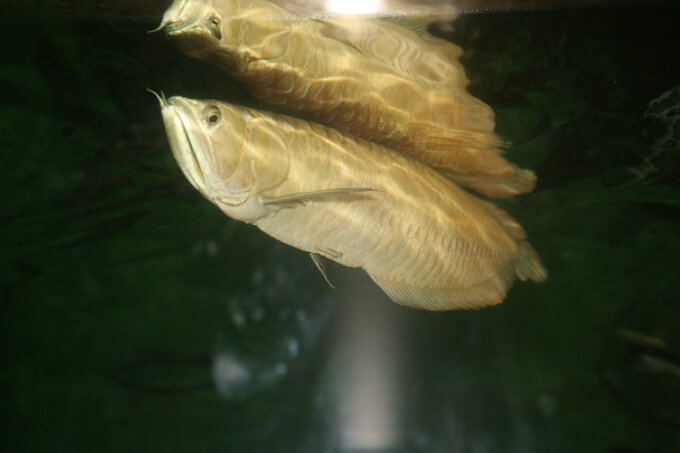
This species is a banded fish. That means that it has a long and slender body. They look flat from the side and resemble a ribbon.
Wide dorsal and anal fins stretch from the middle of the body down to the tapered tail. The fins look so uniform that it can be difficult to distinguish where the dorsal fin ends and the caudal fin begins.
Silver Arowanas are one of the most predatory fish in the trade. They have massive hinging jaws that can gobble up other fish in an instant! It is possible to keep Silver Arowanas with other fish. But, it all comes down to your fish’s temperament and aggression levels.
Luckily, they are beautiful on their own and don’t mind living in solitude.
- Size: 3 feet
- Difficulty: Expert
- Minimum Tank Size: 250 gallons
19. Texas Cichlid
Usually found in the Rio Grande, the Texas Cichlid is a real head-turner. They add tons of neon color to your tank when the conditions are right.

The background color of the fish is dark grey or brown. But several spots of iridescent blue cover the body. Some specimens also have large dots of black, which are typically underneath those shimmering spots of blue.
Texas Cichlids are agile swimmers. Thus, they require a lot of open swimming space. Provide a mix of sand and fine gravel for the substrate. Then, introduce plants and rocks sparingly.
Unlike other Cichlid species, these fish prefer more open space than dense vegetation.
As young fish, Texas Cichlids are quite peaceful. They can get along with other peaceful species without behavioral problems. But, that changes when they reach adulthood.
In the wild, these fish live a life of solitude. They can be kept with other aggressive fish, but they’ll need a sizable environment.
- Size: 12 inches
- Difficulty: Intermediate
- Minimum Tank Size: 50 gallons
20. Peacock Bass Cichlid
Many people mistake this fish for a standard bigmouth Bass. Despite its similar looks, the Peacock Bass Cichlid belongs to the Cichlidae family.
It has some beautiful color patterns. You’ll find sections of olive green that transition to a bright yellow. Hints of red and white are common, too. The same goes for black patches and a signature eyespot on the tail.
One reason why people might mistake this fish for a Bass is that it’s used as a game fish in southern Florida. They were introduced into canals and lakes. Contrary to other species introduced to new habitats, the Peacock Bass Cichlid thrives in this area. It even improved populations of other fish!
In aquariums, the Peacock Bass Fish can be a handful. Not only are they aggressive, but they produce a considerable amount of waste. To prevent ammonia and nitrates from affecting their health, a solid filtration system is a must.
- Size: 30 inches
- Difficulty: Intermediate-Expert
- Minimum Tank Size: 200 gallons
21. Oscar Fish
One of the most identifiable Cichlid species in the world is the Oscar. Also known as the Velvet Cichlid, these fish are incredibly popular in the aquarium trade.
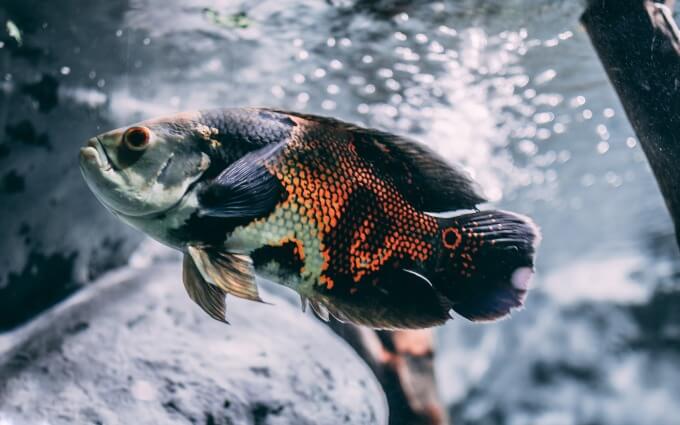
Mostly black, the fish’s body is accented with colors of orange, red, and gray. These colors combine to create a truly unique appearance that you have to see to appreciate!
For the most part, Oscar Cichlids aren’t too difficult to care for. They adapt well to most conditions as long as you stick within the accepted parameters. You won’t even need any special filtration or current generators.
These fish are easy to feed as well. Unlike other fish on this list, Oscars aren’t pure carnivores. They will accept processed foods and nibble on plants.
The main issue you might encounter is its temperament. Oscar Cichlids are known bullies that will attack and eat any vulnerable fish. If you want to add some tank mates, make sure that you’re getting aggressive fish that can hold their own against the Oscar.
- Size: 10 to 12 inches
- Difficulty: Intermediate
- Minimum Tank Size: 55 gallons
22. Jack Dempsey Fish
Named after the famous boxer, Jack Dempsey Fish is a hardy species that does well in home aquariums. It can tolerate hotter temperatures than most fish, giving you a bit of wiggle room when conditions go awry.

There are several types of Jack Dempsey Fish. The most common is covered in iridescent spots of blue, gold, and even purple. Those colors sit on top of a neutral gray backdrop.
The reason these fish are named after Jack Dempsey is their face! Like the boxer, they have strong facial muscles. Their bodies are pretty strong and agile, too.
Technically speaking, these fish are Cichlids. Thus, they have the temperament to match. There are more docile variants, but most of the Jack Dempsey Fish you’ll find in the trade are aggressive.
To keep fighting to a minimum, add rocks, driftwood, and caves to the tank. They are territorial creatures, so hiding spaces will give them a space to claim as their own.
- Size: 10 to 15 inches
- Difficulty: Intermediate
- Minimum Tank Size: 55 gallons
23. Mini Dovii
The Mini Dovii is a rare fish with a lot to offer. Also known as the Sieve Cichlid, these fish make beautiful additions to the right tank.
The body of the fish is covered in red dots. What’s interesting about this coloration is that the dots look almost uniform. On the fish’s side, many of the dots line up perfectly to create a distinct linear pattern.
Larger patches of black usually blend in with the background color of the fish. You might also see some bright red edges on the fin.
Mini Dovii fish are very territorial. This behavior is present all of the time. But, it gets more noticeably when other Mini Dovii are in the tank.
If the Mini Dovii is living with other aggressive Cichlids, they tend to worry less about fighting. As always, provide plenty of decorations in the tank to avoid unbroken lines of sight.
- Size: 12 inches
- Difficulty: Beginner-Intermediate
- Minimum Tank Size: 75 gallons
Conclusion
As you can see, some of the most aggressive freshwater fish actually have a lot to offer. You’ve probably heard about many of them already!
As long as you follow the care guidelines and recommendations there’s actually not much to worry about when it comes to owning these species. But that still doesn’t spoil how unique and exciting they can be.
We hope this list helps you pick the next species for your home tank. If you have any questions feel free to message us directly. We’re always eager to help our readers!

